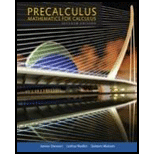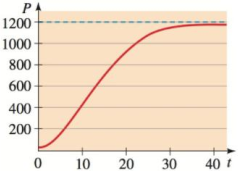
Concept explainers
Logistic Growth Animal populations are not capable of unrestricted growth because of limited habitat and food supplies. Under such conditions the population follows a logistic growth model:
where c, d, and k are positive constants. For a certain fish population in a small pond d = 1200, k = 11, c = 0.2, and t is measured in years. The fish were introduced into the pond at time t = 0.
- (a) How many fish were originally put in the pond?
- (b) Find the population after 10, 20, and 30 years.
- (c) Evaluate P(t) for large values of t. What value does the population approach as t → ∞? Does the graph shown confirm your calculations?

Trending nowThis is a popular solution!

Chapter 4 Solutions
PRECALC.MATH.F/CALC.(LL) >CUSTOM PKG.<
- Algebra & Trigonometry with Analytic GeometryAlgebraISBN:9781133382119Author:SwokowskiPublisher:Cengage


 Glencoe Algebra 1, Student Edition, 9780079039897...AlgebraISBN:9780079039897Author:CarterPublisher:McGraw Hill
Glencoe Algebra 1, Student Edition, 9780079039897...AlgebraISBN:9780079039897Author:CarterPublisher:McGraw Hill Functions and Change: A Modeling Approach to Coll...AlgebraISBN:9781337111348Author:Bruce Crauder, Benny Evans, Alan NoellPublisher:Cengage Learning
Functions and Change: A Modeling Approach to Coll...AlgebraISBN:9781337111348Author:Bruce Crauder, Benny Evans, Alan NoellPublisher:Cengage Learning Linear Algebra: A Modern IntroductionAlgebraISBN:9781285463247Author:David PoolePublisher:Cengage Learning
Linear Algebra: A Modern IntroductionAlgebraISBN:9781285463247Author:David PoolePublisher:Cengage Learning





